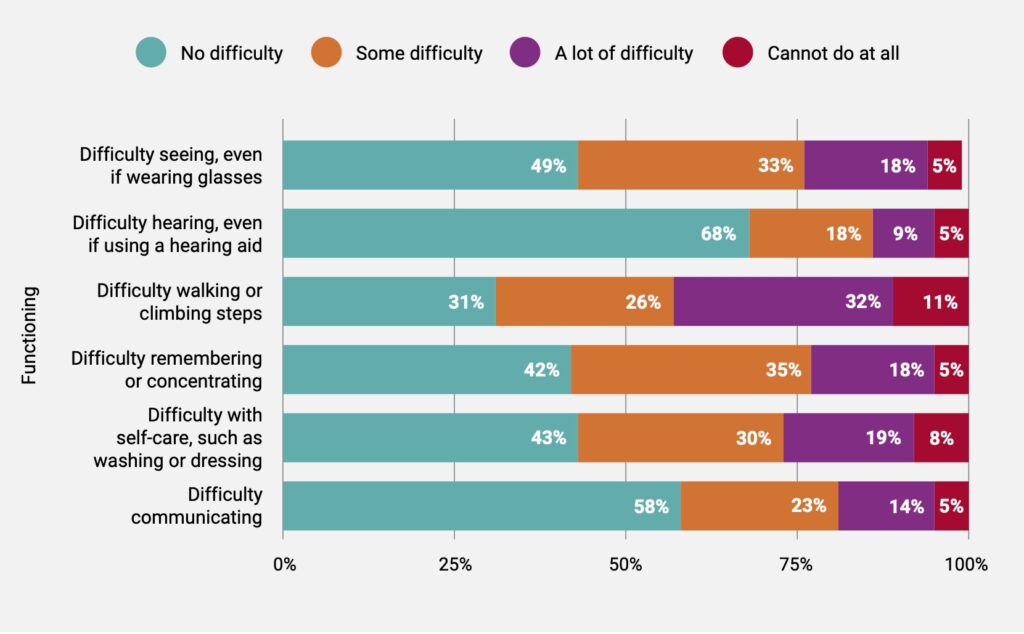Historic Buildings and Special Needs Safety in Emergencies
Many historic buildings do not allow compliance with current accessibility standards required by national or local legislation, nor can they be adequately modified to achieve the objective of safety for all. This problem makes it necessary to provide, on a case-by-case basis, a framework of measures capable of guaranteeing the required level of safety by making use of organizational and plant engineering measures suitable for limiting the risks.
According the UNDRR (UN Office for Disaster Risk Reduction) 2023 Global Survey on Persons with Disabilities and Disasters people with special needs are particularly vulnerable during emergencies, as their disabilities amplify the risks to which all people are exposed during disasters of natural or human origin. Many historic buildings do not allow compliance with current accessibility standards required by national or local legislation, nor can they be adequately modified to achieve the objective of safety for all. This problem makes it necessary to provide, case by case, a framework of measures capable of guaranteeing the required level of safety by making use of organizational and plant measures suitable to contain the risks.

(Mary Harrsch from Springfield, Oregon, USA, CC BY-SA 2.0 https://creativecommons.org/licenses/by-sa/2.0, via Wikimedia Commons)
Starting from the ability to receive and understand alarm messages up to the difficulties related to evacuation, all phases of emergency planning must take into account everyone’s functional needs. This involves knowing the distribution of individual needs in a given population and the availability of information on behavior in the event of an emergency. In this context, the 2023 Global Survey Report on People with Disabilities and Disasters from the United Nations Office for Disaster Risk Reduction provides insights important also for culturale heritage sites. Over time, the rules and indications on emergency exodus have been constantly improved to guarantee the achievement of safety objectives in the event of fire for all people present in the buildings. This, regardless of the functional needs of individuals. Unfortunately, from buildings to even larger outdoor areas, in many cases some deficiencies are not adequately addressed or resolved.
Main existing gaps
The main gaps still existing that can be found in the context described can be summarized as follows:
- Limited Mobility: Many elderly and disabled individuals face mobility issues, making it challenging to evacuate quickly. The lack of accessible transportation and evacuation routes further complicates the situation.
- Specialized Care Needs: Evacuating individuals with specific medical needs requires a coordinated effort to ensure they have access to necessary medications, medical equipment, and specialized care, such as assistance with mobility aids.
- Communication Barriers: Clear and timely communication is crucial during evacuation efforts. Elderly and disabled individuals may face communication barriers, making it difficult for them to receive timely information about evacuation orders and instructions.
- Shelter Accessibility: Evacuation shelters may not always be equipped to accommodate the unique needs of elderly and disabled individuals. This includes providing accessible facilities, medical support, and trained personnel.
- Evacuation Planning: Developing comprehensive evacuation plans that specifically address the needs of elderly and disabled individuals is essential. This includes identifying accessible routes, organizing transportation, and ensuring the availability of necessary resources.

The design of safety measures is also linked to the estimate of the number of people who may have specific needs in a standard population. In this regard, remembering that safety design, like that of environments, must possibly resolve all possible problems linked to particular needs, in historic buildings the problem arises of how to remedy aspects that cannot be treated with an adaptation of the areas built.
The first data to be acquired therefore concerns the number of individuals whose needs must be addressed with specific measures. The UNDRR survey can prove useful for sizing specific measures.
Distribution of function limitations within the population
- 23 per cent of respondents reported a lot of difficulty seeing or could not see at all. That means that information must always be conveyed through methods that allow this part of the population understanding what’s happening and what to do. Therefore, for example, text messages of alert must also be accompanied by sound messages;
- 14 per cent of respondents reported a lot of difficulty hearing or could not hear at all. The same considerations stated for the difficulty in seeing apply to cases in which only voice messages or audible alarms are relied upon;
- 43 per cent reported a lot of difficulty walking or climbing steps or were unable to do so. In this case, emergency planning should be tailored in order to deploy first responders to help people in the right time and place. Approaching this aspect could be helpful to of emergency management the awareness in real time about the location of people with functional need exposed to risk;
- 23 per cent of respondents reported a lot of difficulty with remembering or concentrating or could not do so at all. The general problem of cognitive difficulties is one of the most complex part of the problem. At the moment only tailored plans can give an adequate answer to this need.
- 19 per cent reported a lot of difficulty communicating or being understood in their own language or could not do so at all. The fast development of technologies can dramatically help to solve the specific problem, given that the tools should be available in emergency conditions.
To assess whether a large-scale evacuation plan is realistic, one of the first things to check is how many people need assistance and what nature of assistance is required. In this regard, the Survey recalls the following results.
Capability to evacuate without assistance
To address the aspect of evacuation without assistance, it should be kept in mind that only 26 percent of those interviewed declared that they had no difficulty in evacuating immediately and without assistance.

According to the direct experiences in emergency situations of the people who participated in the survey, if they could evacuate with sufficient notice only 39% said they would have no difficulty evacuating. For the remaining part of the population it must be taken into account that:
- 29 percent expressed encountering significant difficulty in immediate evacuation and 35 percent of respondents indicated facing some challenges evacuating immediately and without aid. Even in this case, emergency planning should be tailored to deploy first responders to help people in the right time and place;
- 10 percent reported being unable to evacuate immediately without assistance
- 38 percent stated they would have some difficulty evacuating
- 17 percent reported encountering substantial challenges in evacuation
- 6 percent mentioned their inability to evacuate independently even with advance notice.
The figure presented in the Survey show a complex situation: hardly an emergency evacuation plan seems to have been developed considering that only 26 percent of population “stated having no trouble evacuating immediately and unassisted”.
In general, a substantial improvement of the plans could occur through the adoption of complementary measures that concern the improvement of real-time situational awareness by rescuers, the training of rescuers to assist in evacuation, and the definition, when possible, of personal early warning and evacuation plans.
Preparedness
The Survey also addressed the problem of preparedness, which showed results consistent with the aspect previously treated. In this regard:
- 84 per cent of persons with disabilities reported not having a personal preparedness plan for disasters
- 17 per cent would still face a lot of difficulties evacuating even if adequate early warning enables persons with disabilities to evacuate with fewer difficulties, even incase of sufficient advance warning
- 6 per cent would be unable to evacuate independently at all
- 56 per cent reported not being aware of or not having access to disaster risk information in accessible formats in their communities, while awareness of disaster risk plans remains low among persons with disabilities
To improve preparedness, the activities to be carried out have partly been described previously and partly concern information on risks and how to behave in the event of a disaster.
Conclusions
The main implications that we can highlight from the Survey in improving the approach to emergency planning and disaster preparedness can be summarized in some points:
- the majority of persons with disabilities (84 percent) do not possess a personal preparedness plan.
- only 26 percent of respondents stated having no trouble evacuating immediately and unassisted.
- among those persons with disabilities who reported having preparedness plans, priorities mainly centered around evacuation planning and possessing a preparedness kit, such as a grab bag. Some highlighted the necessity to improve their knowledge and skills related to preparedness planning.
- 10 percent percentage of persons with disabilities reported being unable to evacuate immediately without assistance.
- the findings of the Survey indicate that if adequate early warning is provided, 39 percent of respondents stated no difficulty in evacuating but 23 percent still face significant difficulty or are unable to evacuate without assistance.
- more than half of the respondents (56 percent) reported either not being aware of or lacking access to disaster risk information in accessible formats.
- these values can be considered remarkably high when it comes to sizing a rescue device that must intervene in disasters that affect a larger scale than a single building.
- a significant portion of respondents —28 percent—indicated never having someone available to assist them with evacuation, even when necessary.
The data contained in the United Nations DRR Survey provide important indications on the percentage composition of the functional needs of a population. This data may also be useful for developing measures and above all emergency plans suited to everyone’s needs. Even if the extension of the interviewees is extremely low compared to the population exposed to disasters, the methodology adopted and the data constitute valuable information for improving emergency plans and for carrying out future research aimed at a better use of simulation and evacuation planning tools.





